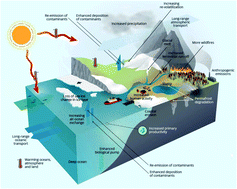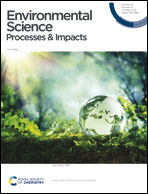Climate change influence on the levels and trends of persistent organic pollutants (POPs) and chemicals of emerging Arctic concern (CEACs) in the Arctic physical environment – a review†
Abstract
Climate change brings about significant changes in the physical environment in the Arctic. Increasing temperatures, sea ice retreat, slumping permafrost, changing sea ice regimes, glacial loss and changes in precipitation patterns can all affect how contaminants distribute within the Arctic environment and subsequently impact the Arctic ecosystems. In this review, we summarized observed evidence of the influence of climate change on contaminant circulation and transport among various Arctic environment media, including air, ice, snow, permafrost, fresh water and the marine environment. We have also drawn on parallel examples observed in Antarctica and the Tibetan Plateau, to broaden the discussion on how climate change may influence contaminant fate in similar cold-climate ecosystems. Significant knowledge gaps on indirect effects of climate change on contaminants in the Arctic environment, including those of extreme weather events, increase in forests fires, and enhanced human activities leading to new local contaminant emissions, have been identified. Enhanced mobilization of contaminants to marine and freshwater ecosystems has been observed as a result of climate change, but better linkages need to be made between these observed effects with subsequent exposure and accumulation of contaminants in biota. Emerging issues include those of Arctic contamination by microplastics and higher molecular weight halogenated natural products (hHNPs) and the implications of such contamination in a changing Arctic environment is explored.

- This article is part of the themed collections: Recent Open Access Articles, Best Papers 2022 – Environmental Science: Processes & Impacts, POPs and Chemicals of Emerging Arctic Concern: Influence of Climate Change and SDG13: Climate Action – Ozone Depletion


 Please wait while we load your content...
Please wait while we load your content...